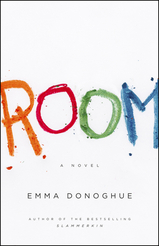 Room by Emma DonoghueLittle, Brown and Company, 2010The winner of a 2011 Alex Award as a book written for adults that has appeal for teens, Room is certainly not for the faint of heart.Jack has just turned five. He and his Ma live in Room, a fortified soundproofed outbuilding where his mother has been kept prisoner for seven years by Old Nick. Although Old Nick is Jack's father, Jack has never laid eyes on him as he visits only at night after Jack has gone to sleep in the wardrobe. Things take a turn for the worse shortly after Jack's birthday and Ma begins to make plans for escape, involving a reluctant Jack who can hardly get his head around the fact that a world exists outside Room, where he is happy and content. Room is told entirely through Jack's eyes, which makes for a fascinating perspective on both the situation he is in and how his mother reacts. As he doesn't know anything different, to him Room is as good as it gets. His perception of television is that it is transmitted from other worlds, and he truly believes that Dora the Explorer is his friend. Despite his naivete Jack is intelligent and is skilled at language. It is actually quite astonishing how diligent Ma has been in trying to keep him physically and mentally healthy in Room. Ma was young when she was kidnapped by Old Nick, and after seven years of captivity she is still only in her mid-twenties. She finally reaches her breaking point when Old Nick shuts off their power and heat for a few days and begins planning their escape. Jack trying to get his head around the outside world is an interesting process, and certainly Donoghue had her work cut out for her narrating from a five-year-old's perspective. There isn't much action in this novel, but what action there is I found extremely suspenseful. Room is far more about character and what people do to survive trauma, and seeing Ma struggle with newfound freedom and Jack trying to make some sense of the world outside Room - as well as the fact that he may sometimes be farther than a few feet away from Ma - was poignant. I believe that older teens will find much to capture their attention here, especially as Ma was a teen when she was kidnapped. Certainly not a light read, it will undoubtedly continue to engender discussion.
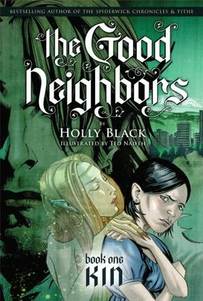 Kin (The good neighbors, book 1) by Holly Black (text) & Ted Naifeh (art)
Graphix, 2008
Rue's mother has been missing for three weeks and her professor father is becoming increasingly distant. Rue is struggling to live a reasonably normal life - going to school, hanging out with her friends - and ignore the strange creatures she keeps seeing. When her father is accused of murdering a young woman, Rue tries to get to the bottom of what really happened to the young woman as well as her mother, and finds far more than she bargained for.
I've been a fan of Holly Black since reading both The Spiderwick Chronicles and Tithe a few years ago, and Kin certainly reinforced to me her interest in and ability to write about humans (and people who initially believe that they are human) encountering the faerie realm. I have to say that I enjoyed both Tithe and The Spiderwick Chronicles more, however, and I'm having trouble putting my finger on why.
Naifeh's art, for one thing, is stunning. The style of both the drawing and the characters is distinctive, and the atmosphere is dark yet not particularly ominous. Rue's expressions and body language are exquisite, both of which lent meaning to her words. I also enjoyed the use of different perspectives and panel layouts throughout the book, and I appreciated how items seen early in the story turned up in a more significant way later on.
The story is more ominous than the drawings, and there is a sense of everything being not quite as it seems from the very beginning. Rue's character was well developed but Rue's parents played very little role other than causing plotting to happen, and I didn't have a sense of them as personalities. It seemed that way with many of the characters, but I'm hesitant to jump to that conclusion seeing as this is the first book in a series. Nonetheless, it felt to me as if Rue was the only "real" character in the book.
To be clear, I don't dislike Kin: it's gorgeous to look at and I am curious to see what's in store for Rue. I will seek out the sequels in the hopes that I enjoy them more.
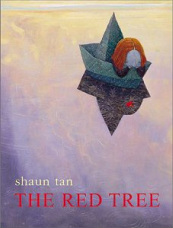 The red tree by Shaun TanSimply Read Books, 2003I unabashedly adore Shaun Tan. It should be noted that this was not the case before I read The red tree. Granted, I think his The arrival is a work of genius, but The red tree spoke to me so vividly that I would probably be struck dumb if ever I was lucky enough to meet him. The premise of The red tree is simple: a young girl wakes up and "...the day begins / with nothing to look forward to / and things go from bad to worse,"* until the end of the day when something remarkable happens. The execution, however, is anything but simple: the illustrations are stunning and the text is spare and poetic. The phrases Tan uses get right to the point, from "nobody understands" to "sometimes you just don't know what you are supposed to do." Hopelessness, fear, and yearning permeate this day in the small girl's life. The illustrations start out simply, with a depiction of the girl getting out of bed taking up about a fifth of the story's initial two-page spread. They do not stay simple however, and scenes straight out of a dark fantasy emerge. From desolate landscapes to massive mechanical dragons and ships in roiling seas, the small protagonist encounters a long sequence of unwelcoming environments. A lone red leaf is with her throughout her day, something that I did not catch until I read the book a second time. Having read two of Shaun Tan's other books - The arrival (2007)and Tales from outer suburbia (2008) - it is fascinating to see how some visual elements from The red tree are also found in those books. For example, one of the earliest scenes in The red tree shows the girl with a large old-fashioned submarine helmet on her head, which is very similar to the helmet found on the cover of an edition of Tales from outer suburbia. While the human characters in The arrival are more realistic in their features, the alien space and objects in The red tree have similarities to the atmosphere in The arrival. This is a book that is, arguably, for older students. While it is as dark as it is beautiful, I would not shy away from having it in an elementary library. However, I believe that older students, especially teens, would get a lot more out of The red tree. As an adolescent I remember often feeling hopeless, misunderstood, and like nothing good would ever happen to me, and anecdotal evidence suggests that many others would agree. The red tree is a beautiful, poignant book that I will purchase for the school libraries I manage, and a thousand thanks to my professor for the recommendation. *Another unpaginated picture book! These lines are the first three lines of the book, but all other quotes in this review will not be given a page reference.
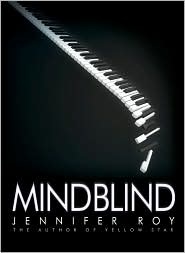 Mindblind by Jennifer RoyMarshall Cavendish, 2010Nathaniel is fourteen years old, enjoys video games and The Amazing Race, and plays keyboards in a band with his best friend and the girl he adores. He is also a homeschooled university graduate, very skilled at mathematics, and has Asperger syndome. Nathaniel's life goal is to be an official genius, which is what many people consider him to be due to his incredible memory and knowledge. However, according to a book he read when he was seven years old, someone must "accomplish something outstanding" (p. 14) before he or she can be considered a genius, so Nathaniel is determined to meet that objective as soon as he can. It remains to be seen if life will get in the way of his goal, and how he might manage to achieve it. Nathaniel has a typically complex teenage life: a girl he secretly has a crush on, divorced parents, not getting along with his father, and an embarrassing episode at a party. On top of that, he struggles to communicate with his family and friends due to his difficulty interpreting social cues, but he is an eminently likable person and quite self-aware. I enjoyed seeing the world from Nathaniel's perspective. The supporting characters have a lot going on as well. Nathaniel's mother was a highlight for me, and her interactions with Nathaniel were kind, firm, and she often exhibited a sense of humour. In many ways, Nathaniel's father is the villain of the book in that he steadfastly refuses to try to relate to Nathaniel in a manner that is outside his comfort zone or expectations. The developing relationships that Nathaniel has with his father's wife and his four-year-old half-brother were lovely to observe, and Nathaniel's best friend Cooper was solid as a rock. So many people in Nathaniel's life were supportive of him and his gradual awareness of this was heartwarming. Author Jennifer Roy has taken her experiences with her son (who, according to her website, also has Asperger syndrome and his highly gifted) and as a teacher and woven them into Mindblind. Thoughtful, humourous, illuminating, and highly recommended.
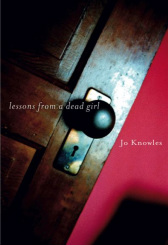 Lessons from a dead girl by Jo Knowles
Candlewick, 2007
Beautiful, popular Leah takes awkward Laine under her wing when they are in fifth grade and declares them to be friends forever. Laine is confused by the attention but happily goes along with it. Laine even goes along with Leah's insistence that they secretly "practice" for marriage together, although Laine becomes increasingly confused by what it means about her relationship with Leah. While the girls grow apart as they enter high school, Leah maintains a powerful hold over Laine until a public confrontation results in tragedy.
Knowles tackles the topic of sexual abuse between children head-on, and she does it with a remarkably delicate touch while pulling no punches. Laine's confusion and desperation to keep Leah happy, as well as the tension between Laine and Leah in the years after their "practice" ends, are well-rendered. Although there are certainly scenes that are uncomfortable as a reader, nothing is graphically presented and the narrative focuses primarily on the emotions of the characters, especially Laine as the novel is from her point of view.
Leah and Laine are three-dimensional characters with specific and evident motivations, and their respective evolutions as they grow into teenagers are unsurprising but nonetheless poignant. Although I know very little about this topic, it would appear that the author did a good deal of research to create such believable characters, and this novel was an emotional and educational introduction to the subject and will not soon be forgotten.
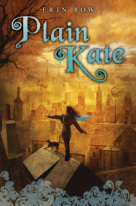 Plain Kate by Erin BowArthur A. Levine Books (Scholastic), 2010Let me start at the end: I was reduced to not a slightly teary, not a delicately weepy, but a blubbering, sobbing mess at the end of this book. I haven't cried so much because of a book since I struggled to read the last chapters of Tolkien's The Return of the King through a veil of tears, a comparison which may give you an indication of both how invested I was in the characters and the effectiveness of Bow's world-building. Bow's prose certainly reflects the fact that she is a published poet, with phrases like "the sky had slid shut under a lid of low clouds" (p. 30) appearing throughout. This lyricism lent itself well to the dark, magical world that Plain Kate inhabits and tries her best to make her way safely through. The book is very atmospheric, and I could almost feel the cold damp of the fog traveling upriver, or hear the mud pulling at the bottom of Plain Kate's boots. The novel has a distinct Medieval, Eastern European feel to it, with towns and cities located at great distances from one another and tinkers and merchants selling their wares in outdoor markets.Plain Kate is an evocative main character. She reveals herself slowly to other characters as well as to the reader, and coming to know her gradually made her feel all the more real. Her constant companion, Taggle the cat, is a wonderful comic foil to Plain Kate's seriousness while remaining an exceedingly loyal companion (despite his derision for dogs). Secondary characters, such as Drina and Behjet, are three-dimensional with their own tangled beliefs and personal sorrows that are hinted at and not always explained, leaving the reader to draw their own conclusions. As in reality, people and events were not always tied up neatly, which makes it easier to believe that the world in Plain Kate has no boundaries and continues to exist. Although it took me a few dozen pages to get truly sucked into Plain Kate, once I was in it I wasn't prepared to leave until I got to the end. Had someone asked me after the first chapter if I would be an emotional wreck at the end of the book, I would have given a definitive no. I am exceedingly glad that I would have been wrong, and I will be recommending this book to many. Edited February 15th to add: I just found a fantastic book trailer for Plain Kate made by Scholastic:
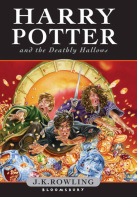 Harry Potter and the Deathly Hallows by J.K. Rowling
Raincoast Books, 2007
Admittedly, it is a source of youth librarian shame that I haven't read the final Harry Potter book until now, years after it was published. Better late than never, I suppose!
As the last book in the ground-breaking series, I had high hopes for this novel, and for the most part I wasn't disappointed. The characters remained as consistent as always, loose ends were tied up, and tension and suspense permeated the entire novel. I particularly enjoyed learning about Dumbledore's past and watching Harry grapple with what he should believe about his mentor. I have also been curious about Snape's true motivations and that, too, was revealed.
My favourite parts of the novel were the lighter bits, of which there were few. The Weasley family as a whole are the group of characters I enjoy the most throughout the series, especially the family dynamics and Fred and George's antics, and the funnier moments in the book almost invariably involved one Weasley or another.
One thing I have always admired about Rowling's writing is her ability to keep information hidden from both the book's characters and the reader, while making the thread of logic and discovery make complete sense once the revelation comes out. One of my gripes about some children's literature is that crucial bits of information are terribly obvious to the reader but the characters just can't seem to see what is right in front of their noses, and this often frustrates me. I have never had this frustration with Rowling.
*Spoilers ahead* My one gripe about this book is the climatic final battle between Harry and Voldemort. For something that has taken seven books and thousands of pages to come to a head, I found it disappointing. While most of their direct conflicts involved Harry surviving due to a twist of logic or something Voldemort forgot about, the final battle between the two seemed very quick and wordy and (again) involved something Voldemort didn't consider in his calculations and his overall underestimation of Harry. While I can see a lesson there about arrogance vs. reflection, etc., and while I suppose the only way anyone could have defeated Voldemort was by finding holes in his plan and capitalizing on them, the climax wasn't as epic as I would have liked. Sure, there was a Death Eaters and Dementors versus Order of the Phoenix and Hogwarts students battle, but even that was a sideline event. While the pace at the end was breathless and I was very happy to see the end of the Dark Lord, there was something missing for me. *End spoilers*
This is not to say that I wasn't completely sucked into the book for its entirety - in fact, for the final 200 pages I could not bear to put the book down. Perhaps my reaction to the finale was due to the late (early?) hour, but on the other hand I appreciated the epilogue and thought it was an appropriate book-end to the very beginning of Harry's story: on platform 9 3/4. Overall, a satisfying conclusion to a wonderful series.
|







 RSS Feed
RSS Feed